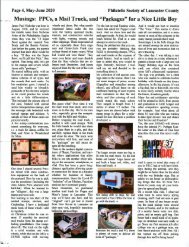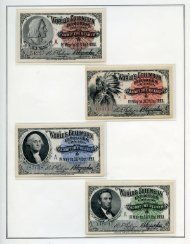August 2018 - Sneak Peek
The American Philatelist is the monthly journal of the American Philatelic Society, the world's largest organization for stamp collectors and enthusiasts. Members receive the printed magazine and can access the digital edition as a benefit of membership in the Society. Please enjoy this sneak peek. We're confident that once you see all that we offer, you'll want to join the APS today.
The American Philatelist is the monthly journal of the American Philatelic Society, the world's largest organization for stamp collectors and enthusiasts. Members receive the printed magazine and can access the digital edition as a benefit of membership in the Society. Please enjoy this sneak peek. We're confident that once you see all that we offer, you'll want to join the APS today.
Create successful ePaper yourself
Turn your PDF publications into a flip-book with our unique Google optimized e-Paper software.
Die proof. Copyright The United States Postal Service,<br />
courtesy of the Smithsonian Institution, National Postal<br />
Museum.<br />
sary Devils Tower National Monument” is spread over three<br />
lines in dark-faced Roman with “50th” in a larger size which<br />
distorts the arrangement of the text. The denomination “3¢”<br />
is in white-faced Gothic.<br />
According to the editors of the Scott catalogs, the color<br />
chosen for the stamp was violet, while the Post Office Department<br />
listed it as purple. In any case, the color is far too<br />
subdued, if not insipid, and fails to capture the contrast between<br />
the outer rock face and the columnar structure that is<br />
a highlight of the tower.<br />
Because the stamp was printed on a Huck press, one<br />
would normally have expected a more crisp and vivid effect<br />
in keeping with the grandeur of the subject. For some reason<br />
this did not occur.<br />
The Subject<br />
In geological terms Devils Tower itself is an impressive<br />
laccolithic formation or sheet intrusion in the shape of a<br />
somewhat tapered column, described by some as a gigantic<br />
stump-like structure. It is composed of igneous rock (solidified<br />
lava or magma) and rises 1,267 feet (386 meters) above<br />
the Belle Fourche River in the Bear Lodge Mountains near<br />
Hulett and Sundance in northeastern Wyoming. Its summit<br />
is 5,112 feet (1,559 meters) above sea level.<br />
The top of the tower consists of an acre of relatively<br />
flat and stony land, covered in part with grasses<br />
of various descriptions and Wyoming big sagebrush.<br />
The surrounding slopes leading up to the tower are<br />
partially enveloped by stands of ponderosa pine,<br />
which at the base of the tower merger into grassland.<br />
The area is home to a host of mammals including<br />
relatively large numbers of the desert cottontail, the<br />
least chipmunk, the black-tailed prairie dog, the red<br />
squirrel, the prairie vole, the porcupine, the raccoon,<br />
the striped skunk and the white tailed deer. Commonly<br />
found birds include Southwestern turkeys,<br />
bald eagles, American kestrels, prairie falcons, peregrine<br />
falcons and turkey vultures. A frequently<br />
found reptile is the prairie rattlesnake.<br />
Geologists in the 19th century who studied<br />
Devils Tower came to the conclusion that it was<br />
formed by what they called an igneous intrusion,<br />
that is, a formation in which molten rock (magma)<br />
was trapped beneath the surface of the Earth and<br />
pushed the rock located above it into a dome-like<br />
shape). However, to this day there is no agreement<br />
about how that process took place. Some describe<br />
the tower as an eroded remnant of a large mass of<br />
igneous rock that intruded through sedimentary<br />
rock beds. Other theories have suggested that Devils<br />
Tower is a volcanic plug or even the neck of an<br />
extinct volcano.<br />
What we do know is that the tower is about 40.5<br />
million years old, and that as the magma cooled,<br />
hexagonal columns formed. Over time, the vertical<br />
columns shrank horizontally, and cracks began to<br />
occur at 120-degree angles, generally forming the<br />
compact six-sided columns that are a hallmark of the monument.<br />
The elements’ continual erosion of the sedimentary rocks<br />
surrounding the base has exposed more of Devils Tower and<br />
has also affected its exposed portions. In particular, rocks<br />
along the columns are subject to water and ice erosion. Portions,<br />
or even entire columns, of rock are continually breaking<br />
off and falling. The presence of piles of broken columns,<br />
boulders, small rocks and stones (scree) that have accumulated<br />
at the base of the tower indicate that it was once wider<br />
than it is today.<br />
Looking at the monument in historical terms, Native<br />
Americans groups, including the Arapaho, Crow, Cheyenne,<br />
Kiowa, Lakota and Shoshone, knew the monolith. Each group<br />
gave it a name and created a myth. The Arapaho called it the<br />
“Bear’s Tipi.” The Crow called it Daxpitcheeaasáao or “Bear’s<br />
House.” The Cheyenne gave it a variety of names: “Bear’s<br />
Lair,” “Bear’s House,” “Bear’s Lodge” and “Bear’s Tipi.” The Kiowa<br />
called it “Aloft on a Rock” or “Tree Rock” and the Lakota<br />
knew it as Matho Thipila (“Bear’s Lodge Butte”), Mateo Tepee<br />
(“Grizzly Bear Lodge”), “Mythic-owl Mountain,” “Grey Horn<br />
770 AMERICAN PHILATELIST / AUGUST <strong>2018</strong>

















